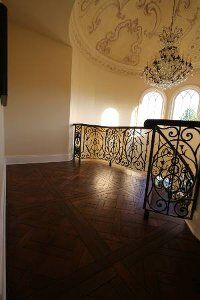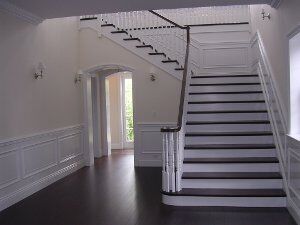The Challenges for Wood Flooring Installers in California
 We had the pleasure of speaking with Marc McCalla, owner of award-winning Craftsman Hardwood Floors, Inc. Marc is an experienced and recognized craftsman specializing in designing advanced installations with wood and stone flooring that are both durable and innovative.
We had the pleasure of speaking with Marc McCalla, owner of award-winning Craftsman Hardwood Floors, Inc. Marc is an experienced and recognized craftsman specializing in designing advanced installations with wood and stone flooring that are both durable and innovative.
Marc received the prestigious “Best Member’s Residence Design Award” by the National Wood Flooring Association.
In this article, Marc graciously shares some of his wood flooring experiences with us…and explains the importance of working as a team with other contractors and ongoing challenges he faces with the fluctuation of humidity in California. He also discusses how he manages projects subjected to those conditions.

When we spoke of working with other general contractors, Marc truly believes communication and relations of all contractors on a site can have a significant impact on the end result of a homeowner’s project. He believes in working as a team and is a strong advocate of having each other’s backs. “When I’m working with other contractors, I like to work with them and establish an attitude of ‘We’re all in on this together’. I make him look good, he makes me look good and consequently, we make everyone happy because the project is successful. We both need to get a great result, because, in the end, our goals are the same.”
When dealing with flooring projects in California’s dry climate, Marc shares his challenging wood flooring experiences he faces in his local area of Santa Clarita:
“In areas of Santa Clarita and within 30 – 35 minutes of the coastal communities, there’s such a fluctuation. We don’t get a lot of rain in California. Our installation practice that we do here is very dry. You have to plan and continually check that you’re not building in too much expansion.
Sometimes people want to install wood floors that are too tight and it’s going to buckle…even though they’ve checked the moisture content of the floor and it’s within 4% and they feel comfortable installing. But as you gain relative humidity inside the house, all the moisture in the air settles on the floor, the floor absorbs the moisture and the wood floor will grow and begin to buckle.
A slightly loose floor is always better than a floor that’s too tight. A floor that’s too tight is going to grow and begin to cup or buckle.
What we’ve learned is that you build in a little bit of expansion. We use shims…smooth-black-metal shims that we use as a growth increment. We take our moisture meter and check the subfloor, check the hardwood and we like to be within 2%…but sometimes, that’s really difficult and unobtainable. In areas where it’s very dry, I try not to use more expansion.
Up in Santa Barbara, the relative humidity is generally about 70%. So if you install a floor, even right now in October, their heating cycle is starting to cool down. What you have to do is build for the next summer. Even though your acclamation and percentage rates state you can install your floor. We build expansion into the floor…and with every three or four rows, we insert a piece of expanding material which may be a 16th of an inch wide. We then cut them into pieces that are 3 inches wide and stagger them every 9 inches apart in each place where there’s a joint in the wood. We continue with the entire row, all the way down from one side of the room to the next.
If you get a tiny gap between a board here and a board there…it will allow your wood floor to grow throughout the winter and summer and it will continue to go through that cycle without buckling.”
When asked if a moisture meter gives Marc peace of mind when installing a new wood floor, Marc responded: “I use a moisture meter…in fact, we have two meters. You have to use a moisture meter, especially with a new installation because houses are built more airtight and lumber is milled faster.”
Minimize your risk of catastrophic floor failure with one of the most respected moisture meter manufacturers in the industry and call Wagner Meters today!
Free Download – Wood Flooring Installation: What To Expect
Tony Morgan is a senior technician for Wagner Meters, where he serves on a team for product testing, development, and also customer service and training for moisture measurement products. Along with 19 years field experience for a number of electronics companies, Tony holds a B.A. in Management and his AAS in Electronics Technology.
Last updated on March 17th, 2025


